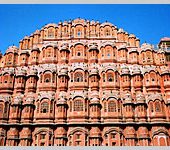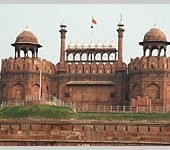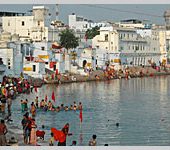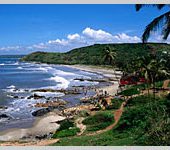This famous city is the capital of Rajasthan and has earned universal renown as “The Pink City “, and pink it is, with beautiful constructed palaces, havelis and forts. Tall, rugged men with handle-bar whiskers sport bright pink turbans.
Jaipur which means the city of victory was built exactly 273 years back and is 262 km by road from Delhi ( Capital of India ). A strong wall encircles the old city and even today has a suggestion of formidable strength, its function of protecting all within is obvious.
The city is remarkable among pre-modern Indian cities for the width and regularity of its streets which are laid out into six sectors separated by broad streets 111 ft (34 m) wide. The urban quarters are further divided by networks of gridded streets. Five quarters wrap around the east, south, and west sides of a central palace quarter, with a sixth quarter immediately to the east. The Palace quarter encloses a sprawling palace complex,(Hawa Mahal), formal gardens, and a small lake. Nahargarh Fort, which was the residence of the King Sawai Jai Singh II, crowns the hill in the northwest corner of the old city. The observatory, Jantar Mantar, is one of the World Heritage Sites. Jaipur is a popular tourist destination in Rajasthan and India.
General Information
Area: 1111117.8 sq.km
Altitude: 431 metres
Climet: 45 max. 25 min. ( summer ) 22 max. 05 min. ( winter )
Languges: English,Hindi,Rajasthani
What To See
- The City Palace
- Jantar Mantar
- Hawa Mahal
- Govind dev ji temple
- Isar Lat
- Ram Niwas Bag
- Birla Planetarium
- Galtaji
- Jaigarh Fort
- Amer Fort
- Nahargargh Fort
- Sisodiya Rani Ka Bag
Architecture
Jaipur is considered by many urbanites to be one of the best planned cities. In an era when most of the Rajputs were busy fighting with each other, Jaipur’s kings diplomatically broadened their control sphere maintaining good relations with the Mughals.
The city was planned according to Indian Vastu Shastra (Vedic Planning for the comfort and prosperity of the citizens). The directions of each street and market are East to West and North to South. The Eastern gate is called Suraj Pol, while the Western gate is called Chand (Moon) Pol. There are three gates facing East, West, and North and a Northern gate (known as Zorawar Singh gate) which faces toward the ancestral capital of Amber, while many gates face South.
Although the present city has expanded from outside of its walls, the original planning was within the walls. The gates used to be closed at sunset and opened at sunrise. Almost all Northern Indian towns of that period presented a chaotic picture of narrow twisting lanes, a confusion of run-down forts, temples, palaces, and temporary shacks that bore no resemblance at all to the principles set out in Hindu architectural manuals which call for strict geometric planning. Thus, for Sawai Jai Singh II and the Bengali advisor Vidyadhar, the founding of Jaipur was also a ritual and a great opportunity to plan a whole town according to the principles of Hindu architectural theory.









